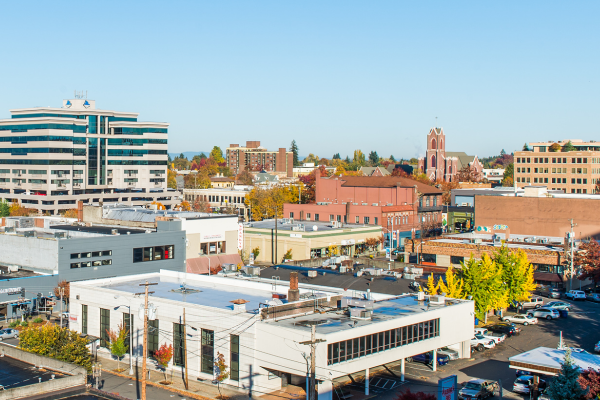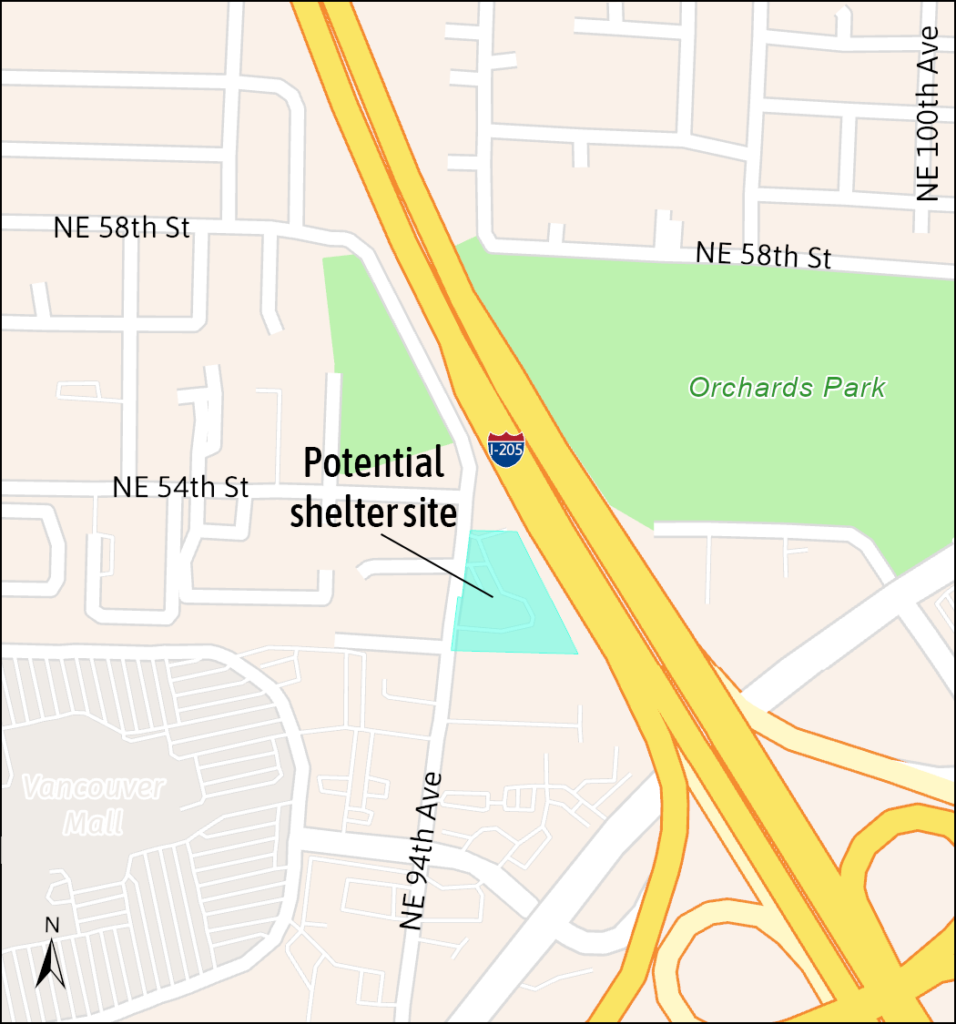Bridge Shelter
Coming 2026
A bridge shelter is a safe place for people experiencing homelessness to stay while they work toward permanent housing. It has fewer entry requirements than some shelters, making it easier for people to get the help they need.

Our progress
In 2023, the City of Vancouver declared a homelessness emergency. A key component of the City’s emergency response action plan includes the opening of a bridge shelter with up to 120 beds. The shelter will provide medication-assisted treatment and other support services to help people transition to stable housing.
The City is working urgently to construct and open the shelter by summer 2026.
Key milestones
Shelter operator hired (Sept. 2024)
In Sept. 2024, the City hired Do Good Multnomah to operate the shelter. Do Good is now working with the City on shelter design and an operations plan.
Shelter architect hired (Dec. 2024)
The City hired Scott Edwards Architecture for shelter design and engineering.
Shelter location approved (Dec. 2024)
Vancouver City Council approved both the purchase and use of property located at 5313 N.E. 94th Ave. as the site for the future shelter. The approximately three-acre property, located in the Van Mall neighborhood, is a good fit for the shelter because of its size, appropriate zoning and proximity to public transit.
Emergency shelters opened (Dec. 2024 – March 2025)
In response to the urgent need for shelter bed space during the coldest months of the year, the City opened select City-owned properties as temporary winter shelters, adding at least 60 beds to the community’s winter shelter offerings until more permanent bed space, like those offered at a future bridge shelter, are available. Shelters will remain open through March 31, 2025.
Stay informed
In Nov. 2024, the City held two community information sessions to explain the bridge shelter plan, answer questions and gather ideas. Watch the Nov. 19 info session recording.
Submit questions to City staff and learn about upcoming engagement opportunities on BeHeard Vancouver.
FAQs
Why do we need a bridge shelter?
While Vancouver’s homelessness response strategies are working, the complexity and magnitude of homelessness in Vancouver continue to grow.When the pandemic hit, homelessness spiked. The number of homeless people in Clark County grew by about a third between 2020 and 2022.
- Since Dec. 2021, the City has more than doubled the number of shelter beds available to adults experiencing homelessness in Clark County – adding up to 160 new beds across the city through our four Safe Stay Communities.
- Since 2021, 424 people have lived in Safe Stay communities, including 87 current residents (as of March). Of the people who have left the Safe Stays, 50% (or 168) moved into stable housing.
Before the Safe Stay program, Clark County had fewer than 100 year-round beds for homeless adults, fewer than 15 beds for single women and no options for couples without children.
Despite this progress, there are not enough shelter beds to house the more than 500 Vancouver residents who remain unsheltered. Without shelter, people have no place to go, and for many, the consequences can be deadly:
- From January through June this year, the Vancouver Fire Department responded to 1,134 medical/EMS calls related to homelessness
- 53 individuals experiencing homelessness died in 2024, representing a 70% increase from the previous year
- 50% of these deaths were due to overdose. These overdose deaths occur largely among people who are living in isolation, either unsheltered or in individual supportive housing.
While there have been overdoses and deaths in shelters, no deaths due to overdose have been reported. In addition to filling a much-needed gap in shelter capacity, the bridge shelter model, including on-site behavioral health services, can provide a lifesaving stepping stone for adults experiencing addiction before transitioning into safe and stable housing.
What services will be available in the bridge shelter?
The bridge shelter will provide 24/7 on-site support by a non-profit operator. To help with the critical needs of those seeking help, the City anticipates the shelter would also include medical respite beds, on-site medication-assisted treatment and other substance use disorder services, peer recovery support, and expanded capacity for severe weather events. To access bridge shelter services, individuals must adhere to a code of conduct outlining expectations for behavior and accountability, like those in place at the City’s Safe Stay and Safe Park communities.
Services
- Day-to-day support: Case management, housing assessments, peer-to-peer recovery support, meals and hygiene services
- Medication-Assisted Treatment Program: Treatment for substance use and mental/behavioral health support
- Respite beds: Beds for those exiting a hospital setting with nowhere to recover
- Other services: Work opportunities, education, animal care/clinics and severe weather shelter
How much will the bridge shelter cost?
Estimated costs
- $6.29 million – cost to purchase the property
- Approximately $14 million – to develop the land and construct the shelter
- Approximately $7 million – annual operating and management cost in the first year. This cost would grow at the rate of inflation annually for the shelter’s 10-year lifespan
Funds to establish the shelter will come from the existing City budget. The City’s 2025-26 budget established a new Business and Occupation tax that will provide most of the funding needed for operation of the shelter. Staff also continue to research additional funding sources, including federal/state grants, private philanthropic donations and interlocal partnerships.
Where will the bridge shelter go?
After researching several potential properties, the City has identified one that could work well for a bridge shelter.
This property, located at 5313 N.E. 94th Ave. in the Van Mall neighborhood, could be a good fit because it’s:
- located on or near a transit line
- zoned for General Commercial, which allows this use
- large enough to accommodate an up to 120-bed shelter (at least 2.5 acres)

How long will the bridge shelter operate?
What kind of code of conduct will exist for those who enter the bridge shelter?
To access services participants must follow a code of conduct/rules. The code of conduct will be developed by the selected service provider, with input from people with lived experience with homelessness and informed by the best practices used for the City’s Safe Stay/Safe Park communities and the needs/concerns of surrounding neighbors and businesses.
Yes. There are many tools to address the complex needs of unsheltered people in Vancouver (Safe Stay Communities, Safe Park, etc.), but no single solution or shelter style will work for everyone. The bridge shelter model will allow us to get many unsheltered adults indoors and safely supported, for the lowest possible cost.
Following the negotiation and acquisition of property for a potential shelter, we mailed an initial postcard notice to all neighbors and businesses within 1,200 feet of the property. Additional community engagement, including an in-person and virtual event, took place in Nov. 2024.
A robust community engagement process, including online and in-person outreach, will help us address community concerns and incorporate feedback into final plans and operating procedures for the future bridge shelter.
We want to hear from you. Follow the project and share your questions on BeHeard Vancouver.

